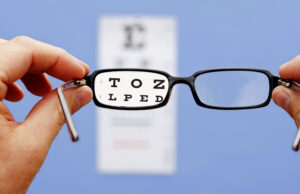March 15, 2023
By Jeffrey Cooper, MS, OD
If you are providing myopia management, it seems logical that you pay attention for accommodative/vergence anomalies since they occur in the same patients and address them.

Identifying myopic patients with binocular vision issues, and developing a protocol, is essential for your patients’ long-term visual health. But what about when it comes time for treatment?
My practice only treats symptomatic accommodative/vergence anomalies. I recommend determining how long your patient can perform near work before some form of asthenopia ensues and using the CISS (Convergence Insufficiency Symptom Survey) to screen for symptoms. Also, if your patient develops symptoms from testing, or demonstrates facial grimacing, treat them.
Treatment
You have three forms of treatment that you can advocate:
- Do nothing (watchful waiting)
- Spectacle lenses, which include both relieving prisms and plus lenses to either reduce accommodative demand or effect binocular alignment via the ACA ratio
- Vision therapy to improve smooth, ramp, or voluntary vergence; and/or surgery.
Obviously, doing nothing has the least ability to reduce or eliminate symptoms.
Spectacle Lenses
Spectacle prisms have been around for a long time. Graphical analysis helped us see the effect of taking a load off the vergence system. Many of us learned about Sheard’s criteria and fixation disparity in optometry school and then forgot about it. Many of us were told that prisms were ineffective because patients “ate” up prism, making them useless. What we did not look at is the use of prism for specific binocular problems and as an adjunct to vision therapy or surgery. Research studies showed that most subjects adapt to prism. For example, if a subject measured orthophoria at distance or near and wore 10 prisms Base Out prism for 30 minutes, they would adapt or measure orthophoria through the prism or demonstrate a 10-diopter esophoria immediately after the prism was removed. If their deviation measured the same amount as the prism they wore, they were said to adapt 100%, but if they measured 8 diopters immediately after removing the prism, they were said to have adapted 80%.
Generally, patients adapt more to BO prism than BI prism. Prism adaptation and slow vergence are the same phenomenon, just a different name. Fast vergence, what we measure with prisms, is reflexive and quickly eliminates the error (phoria) and results in fusion. Slow vergence, takes the load off of the fast vergence system (sustaining power). The system is incredible — over time the extra-ocular muscles change their length by adding or subtracting sarcomeres, to further take a load off the vergence system.
As a general rule, patients who adapt to prism are asymptomatic, and patients with poor adaptation are symptomatic and benefit from the prescription of prism. From this, we learned that prism, when used, is more beneficial for new (full amount) and old (minimal prism) hyper deviations, eso deviations, and for older patients with convergence, insufficiency. We learned from work done by Sheedy and Saladin that patients with symptomatic esos get the most relief by prescribing the amount of eso; and Sheard’s criteria for exos ((2 X phoria — opposing duction)/3). With hyperphorias due to old decompensated hyper deviations, we prescribe the minimal additional prism to reduce symptoms. Young patients in one of the CITT studies had a 30% reduction in symptoms with prism prescription, but they also had a 30% reduction in the control group. They concluded that control lenses had both a significant placebo effect and improvement of symptoms due to regression toward the mean. In any case, prisms should be used in older symptomatic patients who demonstrate minimal adaptation. Adaptation can be indirectly assessed by doing a repeated cover test to assess if the deviation increases with time. Those deviations that increase upon repeated alternate occlusion are indirectly showing the amount of slow vergence.
Sometimes we prescribe prism for patients with intermittent exotropia at near and hypertropia to eliminate diplopia and asthenopia symptoms. We then begin vision therapy to improve compensating fusional amplitudes. Our goal is to slowly wean the patients off the prism. So, we begin by eliminating the problem (fast vergence) and then eliminate the crutch by using slow vergence to eliminate the deviation. Many of our patients aim to eliminate prisms so they can wear their contact lenses.
Alignment, especially in patients with a high ACA ratio such as convergence excess, can be helped with plus lenses. Many of us have been taught complicated formulas that consider the patient’s IPD (intraocular pupillary distance). The result is that we do not use them. I like to make it simple. Forget the IPD. It does not affect the calculation that much. Just remember three things:
- First, an orthophoria patient who views a distance target and then a near target has converged approximately 15 prism diopters.
- Second, measure the relative change from distance to near, e.g., 8 E to 18 E(T) would be 10 additional diopters of convergence.
- Third, total convergence is the sum of 1 and 2 or 25(15-8+18) prism diopters. So, divide that by the accommodative demand, which at 40 cm is 2.5; thus, the ACA would be 25/2.5 or 10/1.
This method lets you quickly calculate the add needed to eliminate a deviation.
You still have to take care of the distance esophoria, so you might add 2-6 diopters BO to your prescription depending on fusional ability. This is a judgment call. After you have reduced the distance error, we will be left with an eso deviation that is 10 prism diopters larger than the distance deviation. To make the patient orthophoric, just divide the deviation by the ACA to determine the add. That would be +1.00, but leave the patient a little exo so make it a +1.25 add. This can be prescribed permanently, or vision therapy can augment the glasses. Horizontal phoria measurements are dynamic; patients often note movement of the targets during testing, so take the average. This observation makes one question the validity of microprisms. Remember, with prisms, you can not wear contact lenses, have LASIK, and be glasses-free. Prisms need to be individualized to the specific needs of the patient, e.g., not all patients have a greater exo at near, and you need to take ACA ratio into account.
Vision Therapy
Vision therapy can eliminate the need for prism, and/or plus lenses. When done properly, it changes both fast and slow vergence permanently. Kind of like learning to ride a bike, it develops the reflex. We know it is very effective for convergence insufficiency and accommodative dysfunction. It can improve symptoms in patients with vertical deviations, esophoria, and divergence insufficiency. With proper treatment, vision therapy can eliminate the deviations in divergence insufficiency. Patients of Asian descent are much more likely to have myopia and intermittent exotropia of the divergence excess type. Thus, this population requires the integration of vision therapy with myopia control. Vision therapy can be done at different levels. Both the American Academy of Ophthalmology and the AAPOS website suggest that home-based vision therapy be performed before advocating in-office therapy with its higher expense. Though I personally disagree with this approach, it does make one aware of the cost and time commitment of in-office therapy. However, following the protocol established by the CITT, in-office therapy is the most effective for convergence insufficiency and accommodative dysfunction, and lifelong is probably the most economical.
You Have A Choice: Refer or Treat
It is the obligation of the examining doctor to make the diagnosis. These accommodative/vergence anomalies are common, and patients deserve the correct diagnosis and to be offered treatment. It is up to them to elect no treatment, active vision therapy, or home vision therapy. The HTS home therapy system (in which the author has a financial interest) is the most widely prescribed system to improve both accommodation and vergence. It uses random dot stereograms in an operant conditioning paradigm to improve accommodation and vergence functioning systematically. When we prescribe only home therapy, generally we also prescribe pushups, HTS, and Brock string. We have trained one of our technicians to train the patient to do these tasks and monitor the patient. You can bill for an orthoptic session, intermediate exam, and the home therapy devices. Have the patient back in three months for a re-evaluation. Your technician can also monitor via the internet.
Like anything else, a well-structured program of vision therapy is optimum. The chances for success increase dramatically. Everything is monitored and coached. This has been demonstrated multiple times in NIH/NEI-supported CITT studies. It is clear that active vision therapy, supplemented with home therapy, following the CITT protocol, is the most effective treatment method. The treatment protocol was developed through the consensus of 11 schools of optometry. Putting vision therapy in your office is a commitment, but it produces the “wow” for patients, and it limits the need to refer out. If you do not refer out or provide binocular vision care, eventually you will lose the patient. Like my orthokeratology patients, these are “wow” patients, and enthusiastic patients build a practice.
Though convergence insufficiency is the most common and most successfully treated binocular anomaly, there are others. Remember that the Asian population, which has the most progressive myopia, is also predisposed to intermittent exotropia of the divergence excess type. This deviation can only be treated with in-office therapy, and it might need surgery to decrease or eliminate the deviation.
Surgery
If the deviation is too large to be handled just with vision therapy, then one should use the skills of a talented strabismus surgeon. Don’t be a hero. Develop a close relationship with good pediatric ophthalmologists. They can eliminate the motor component of the eye turn while you improve sensory-motor functioning. We often combine them, the surgeon decreases the deviation, and we eliminate suppression and increase both fast and slow fusion components. Good surgery is your friend
Summary
If you are providing myopia management, it seems logical that you pay attention for accommodative/vergence anomalies since they occur in the same patients and address them. If you are not providing or you want more education the following references are helpful. Many can be found on my website.
 |
Jeffrey Cooper received his OD from Pennsylvania College of Optometry in 1971 and an MS in Physiological Optics from State University of New York in 1978. He completed a residency in Binocular Vision and Visual Perception in 1971 and subsequently was appointed the co-chairman of the vision therapy department. He taught at the SUNY College of Optometry from 1971 to 2015, where he obtained the rank of Clinical Professor. Dr. Cooper was the principal investigator at SUNY College of Optometry for the NIH/NEI-sponsored CITT (Convergence Insufficiency Treatment Trial). He is the inventor of both Computer Orthoptics and the HTS programs that were used in the CITT clinical trials. He has authored over 60 peer-reviewed papers dealing with anomalies of binocular vision, stereopsis, myopia, myopia treatment, and glaucoma. He is on the advisory boards of VTI, Alcon, Treehouse Eyes, Computer Orthoptics, and Magic Leap. Currently, Dr. Cooper is the principal owner of two practices in Manhattan and Brooklyn. |
References
- Cooper J, Burns C, Cotter S, Daum K, Griffin J, Scheiman M. Optometric clinical practice guideline care of the patient with accommodative and vergence dysfunction 2010. American Optometric Association
- Scheiman M, Wick B. Clinical management of binocular vision : heterophoric, accommodative, and eye movement disorders. 3rd ed. Wolters Kluwer Health/Lippincott Williams & Wilkins; 2020:xii, 748 p.
- Cooper J. Clinical implications of vergence adaptation. Optom Vis Sci. Apr 1992;69(4):300-7.
- Cooper J, Jamal N. Convergence insufficiency-a major review. Optometry (St Louis, Mo. Apr 2012;83(4):137-58.
- Cooper J, Medow N. Intermittent Exotropia of the Divergence Excess Type: Basic and Divergence Excess Type (Major Review). Bin Vis Eye Mus Surg Qtly. 1993;8:187-222.
- Cooper J, Tkatchenko AV. A Review of Current Concepts of the Etiology and Treatment of Myopia. Eye Contact Lens. Jul 2018;44(4):231-247. doi:10.1097/ICL.0000000000000499













